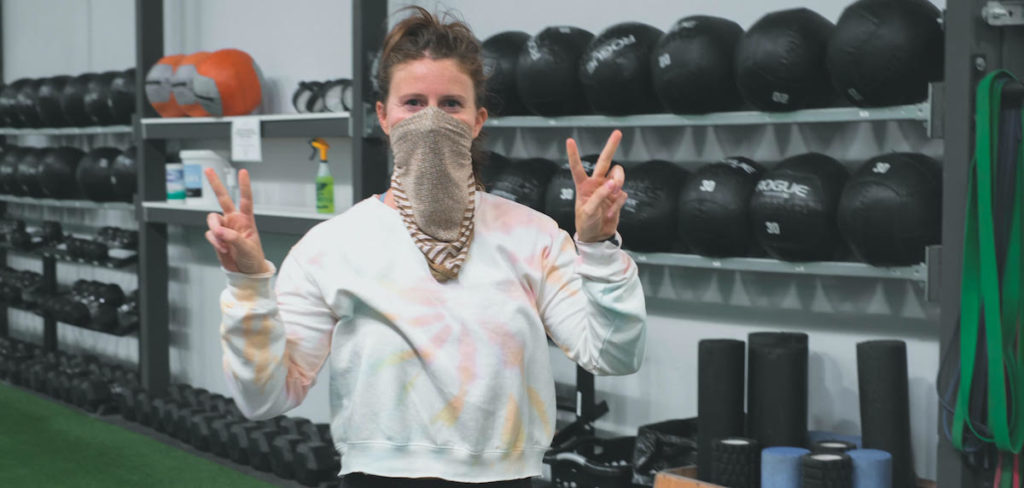Over the years I’ve purchased bandanas solely as a fashion statement—to be tied around my neck, in my hair, or on a handbag. Now that gyms are reopening after mandated closures amid the coronavirus, all said bandanas have since been repurposed as face coverings.
I run a well-established fitness facility in Southern California that, up until this week, had been closed for 88 days. Per the reopening guidelines, the staff is now required to wear a mask of some kind at all times. I’m here to tell you…it’s been an interesting week.
What’s that face?
As humans, we process faces in their entirety, relying on subtle changes in someone’s forehead, eyes, nose, and mouth to read their emotions. The eyes and mouth in particular tend to be the most expressive. For example, the mouth region is particularly good at expressing feelings of happiness. Concealing this part of the face can be problematic in a client-relations industry that relies on coming across as approachable and friendly, all within the first few minutes of meeting someone.
When greeting the 200+ members of our community during their first week back after three months, I found it particularly challenging to express the warmth I felt inside without the ability to show my entire face. Fortunately, hand gestures, body language, words, pitch and tone of voice all work congruously to convey message and intent. Cue lots of hands in the air, some jumping up and down, and air elbow bumps paired with lots of high pitched ‘OMG, I’m so excited to see you’s.’ I found myself jokingly asking the members, “Can you tell I’m smiling with my eyes?”
Keep calm and mask on
We’ve all grown somewhat accustomed to existing with a mask or facial covering. Quick trip into the grocery store, walking to a table at the coffee shop, or running into In N Out for dinner. Not a big deal, 30 minutes max. Totally doable.
Coaching an hour-long session with complex movements like the snatch? That’s a different story. Kirsten Ahrendt, Head Coach and Manager at InVictus Fitness in San Diego, says, “My wife is a nurse, so when she would tell me that she has to wear her mask for a 12-hour shift, I figured I wouldn’t have any problems wearing mine for a few coaching hours at a time…WRONG!”
Our sessions typically begin at the whiteboard where we welcome everyone, check in on their day, and do a quick question of the day. Gone are the days of BS’ing for the first five minutes of class at the whiteboard, commiserating over how sore we are or debating if pineapple on pizza is acceptable (answer: it is). These simple but often powerful attempts to build community feel lackluster with half of our faces covered.
Add in 15 minutes for the coach-led warmup and we’re at almost 20 minutes straight of talking with muffled voices to a large group of folks stationed six feet apart in a 12,000 square foot facility. “Projecting your voice through a piece of fabric…to a room of socially distanced athletes requires a lot of energy,” Ahrendt says.
Back to the whiteboard we go. Now is a good time to mention we run two tracks of programming during our sessions. Briefing two workouts, the intended stimulus, demoing the movements, providing modifications, and answering any questions leaves me gasping for air with a bit of panic in my chest. Now I’m sweating, too.
3-2-1 GO
During the workouts, coaches often rely on global cues and encouragement to keep the group engaged while they’re moving quickly. There’s an idea of being a bigger version of yourself during a class.
Ahrendt notes, “I love utilizing my own outgoing energy to sway the vibe in the room…I don’t feel as effective doing it with the physical distance between folks and the mask on.”
The same gestures that make our community fun and welcoming — singing along with the music, calling out names, and smiling with a head nod to say “I see you working hard, keep going” — don’t seem to have the same effect nowadays.
Not to mention, when the music is blaring and you need to remain physically distanced, cueing is far more challenging. We’ve effectively eliminated verbal and tactile cues, relegated to simple visual representations of the changes we’d like to see in our athletes. Pro tip for all the coaches out there: over-exaggerate the differences so the athlete is able to distinguish between what they’re doing and what you want.
The session is coming to a close with a cool-down and I’m breathing just as heavy as they are from projecting through a mask for the last 60 minutes. There have been a couple of headaches and seeming inability to take a full breath causing some slight anxiety.
“The masks certainly feel encumbering…but I think everyone is just thankful for the opportunity of connection and normalcy that they don’t mind it’s not exactly business as usual,” says Ahrendt.
She’s right. I’ll take a sweaty neck and a sore throat from yelling through a bandana any day over a closed gym, unable to do what I love the most: connecting (in-person!) with the community. Just gonna need a few more bandanas.
Editor’s note: This article is an op-ed. The views expressed herein and in the video are the author’s and don’t necessarily reflect the views of BarBend. Claims, assertions, opinions, and quotes have been sourced exclusively by the author.

